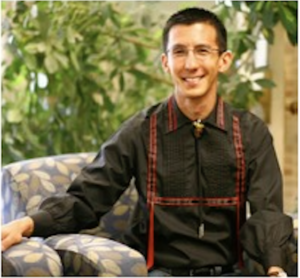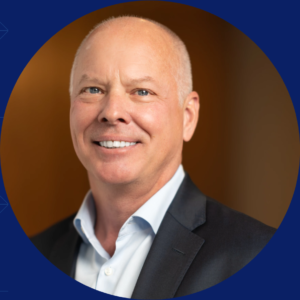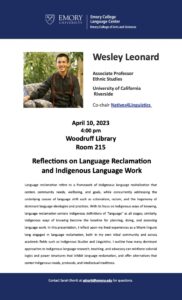

Congratulations to NAIS’s new graduates Iliyah Bruffett and Sierra Talavera-Brown!
Watch the recording of the 2023 Celebration of Native American and Indigenous Gradates here and view the photo gallery of the event here.



Congratulations to NAIS’s new graduates Iliyah Bruffett and Sierra Talavera-Brown!
Watch the recording of the 2023 Celebration of Native American and Indigenous Gradates here and view the photo gallery of the event here.
 On April 10 2023, Dr. Wesley Leonard, citizen of the Miami Tribe of Oklahoma and associate professor at the University of California, Riverside, delivered a lecture about Indigenous reclamation of language. He began with an introduction of himself in myaamia, the Miami lan guage. He then narrated the Miami history of removal, his work to reclaim the Miami language, and explained how Native languages interact with the field of linguistics.
On April 10 2023, Dr. Wesley Leonard, citizen of the Miami Tribe of Oklahoma and associate professor at the University of California, Riverside, delivered a lecture about Indigenous reclamation of language. He began with an introduction of himself in myaamia, the Miami lan guage. He then narrated the Miami history of removal, his work to reclaim the Miami language, and explained how Native languages interact with the field of linguistics.
Dr. Leonard emphasized the difference between revitalization and reclamation of Indigenous languages because these languages are still being spoken. Revitalization invokes bringing life back into a language, but Dr. Leonard argues that these languages were never dead. It was just sleeping until users woke it up.
His central theme was the ”Seven R’s” respecting the land, the language, and the people who use the language; relevance of language education for learners and communities; reflexivity which examines one’s cause for action and prospective; incorporating Native understanding of reciprocity; responsibility of learning the language’s history; rights of the Indigenous users of the language to create their own curriculum; and relationality/relational accountability which is a holistic view of our relationship with our knowledge acquirement and accountability to the users of the language.
Dr. Leonard followed by looking at how the field of academic linguistics’ influences understandings of Native languages. The current study of linguistics breaks down language into subcategories and units. This diminishes the relational understanding integral to Native cultures. Dr. Leonard emphasized that “language is the blanket that holds all of our culture.” He has worked to change the narrative of myaamia from “mining” an “extinct” language created to erase Native history to centering myaamia and other Native languages being actively used in the present.
He concluded his lecture with reaffirming the purpose of Indigenous language reclamation. Reclamation centers on the Native community’s understanding of language, dismantling colonial discourse surrounding languages, promote engagement with communities at various levels of use, and foster allyships grounded in the Seven R’s.

On April 4th, Dr. Lance Frye, the former Surgeon General of the Muscogee Creek Nation, spoke at the Rollins School of Public Health’s third annual National Public Health Week.
Dr. Frye has an expansive background working in residency, private practice, the military, the state of Oklahoma and California, and Tribal governments. He knew his passion in life was to help others and make a difference, especially in the field of women’s health. He shared personal stories on how he met his wife in the army and how his son found himself with six cats. During his time practicing Military Air Space Medicine, he learned how to practice herd health. Dr. Frye traveled to Nicaragua, Uganda, and Malawi. He praised the work of Sister Rosemary Nyirumbe for resisting the army and protecting the young girls of Uganda.
Dr. Frye, who served as the Commissioner of Health for Oklahoma, highlighted some important events that marked the beginning of the COVID-19 pandemic. On March 6th, 2020, the first case of COVID-19 was reported in Oklahoma. This was followed by the cancellation of the Oklahoma City Thunder Game on March 11th, the inability of the Princess Cruise to dock on March 16th, and the initiation of lockdowns on March 24th. At the onset of the pandemic, Oklahoma, like the rest of the country, was unprepared to handle the pandemic and lacked the necessary supplies. The situation looked grim, with an expected death count of 13,000. It was an all-hands-on deck operation. He had to rapidly improve infrastructure, create proper response guidelines, clean up the inner records keeping of the Oklahoma State Department of Health, and fight for personal protective equipment along with many other struggles to protect Oklahoma against the pandemic.
Dr. Frye recounted how the governor of Oklahoma called the National Guard and established a multi-agency command to consolidate resources. He was a part of the Governor’s Solution Task Force as the Commissioner of Health. His task was to get supplies and reach out to the hardest hit facilities: hospitals and senior living facilities. The Oklahoma State University Project Extension for Community Healthcare Outcomes (ECHO) was adopted to connect and relay health information, especially to rural communities. More than 150 ECHO sessions and over 40,000 parties participated in this project. Their main goal for recovery was vaccine promotion and distribution. The rollouts occurred promptly with nurses being vaccinated in December 2020, himself and the governor in March of 2021 and actress Kristin Chenoweth in April of that same year.
The United States was very politically divided over the vaccines and Oklahoma was no different. There were many strong, consistent voices against vaccines and masks who were very influential during policy decisions. The economic shutdown was also a hard decision to enact even though it was the best course of action. Many Tribal governments formed vaccine lines and mobilized large efforts such as talking to casino heads to transferred skills to rolling out the vaccine. These efforts were open to everyone which helped make vaccines accessible. Dr. Frye facilitated many conversations and collaborations with hospitals, suppliers, and other organizations helping the effort.
Dr. Frye and the leadership of Oklahoma felt that they made the correct yet difficult decisions. In 2022, Dr. Frye was appointed as the first Surgeon General of the Muscogee Creek Nation. He entered this role because he felt that he could make a positive change within the Muscogee Nation’s health system. He reflected on how hard it was to operate the public health department. There are 39 federally recognized tribes in Oklahoma because of ongoing historical traumas and complex Tribal-state boundaries. All these need to be addressed within the public health system.
Some of the public health issues Dr. Frye worked to solve is the diet crisis within Tribal nations. The Federal Indian Removal Act of 1831 and the legacies of “Trail of Tears” disrupted traditional food ways and the US rations did not provide the same nutritional value as Native foods from the homeland. Processed food products like flour, lard, and sugar increased the rates of poor health outcomes such as diabetes by three time within the Muscogee Creek Nation. While working through approaches, Dr. Frye and his team looked through historical data, surveyed the opinion of leaders, established a data collection to recoding and share patient information, and worked to ensure that the health services Dr. Frye sought to build met them need of the patients seeking care. One program Dr. Frye enacted to address some of the health concerns of the Muscogee Creek Nation was the Muscogee Creek Nation Diabetes Program. The program included the motto “Stay Active to Stay Healthy”; they boosted hospitals, schools, and cultural center’s resources to support the program. The internal medicine departments of hospitals also hired more specialized healthcare professionals to meet the demands of the program.
A hurdle Dr. Frye worked to overcome was the historical underfunding of Tribal Health by developing a self-governed health care system under the Indian Self-Determination and Education Assistance Act (ISDEAA). The 2020 Supreme Court case McGirt vs Oklahoma upheld Muscogee Creek Nation’s sovereignty and self-governance. State and tribal governments had to adjust for preexisting systems because Muscogee Nation had to build up their own public health system as opposed to sharing departments with Oklahoma. New Tribal policies need to be codified to establish authority, financial allocations, and set public health codes. To create a robust Health Department, Dr. Frye has worked build an inter-tribal and tribal-state collaboration to set up and share essential public health services with Tribal nations who have the best resources to fulfill them.
There are still challenges Dr. Frye faced such as silos of communication, lack of accessible patient data, funding, coordination, collaboration, and complex politics. Dr. Frye ended his talk with the reminder that everyone in public health—by extension healthcare, works together for a common goal. Some of the lessons Dr. Frye has taken from his experience as the first Surgeon General of the Muscogee Creek Nation was the importance of modernized and proactive data to implement preventive measures instead of reactivity. He also focused on the importance of collaboration, competence of providers with Indigenous cultures, and striving for long-term benefits.
On April 26, The Emory News Center announced that the Emory College of Arts and Sciences is set to launch a new Center for Native American and Indigenous Studies this fall to advance and inspire research, scholarship, teaching and learning rooted in and related to Indigenous studies. To read more click here.
New Center for Native and Indigenous Studies set to launch in fall 2023
From Atlanta and want to share your memories of place? Interested in the connection between Atlanta’s history and current environmental health? Want to participate in a public art project and learn how to make paint from your own backyard?
Between May 2 and 13, the Science Gallery Atlanta is inviting community members to participate in a series of 3 workshops and a community art project to explore more about Atlanta. Come tell your story!
This event is facilitated by Heather Bird Harris (an Atlanta-based environmental artist and history educator) and features:
Dr. Eri Saikawa Associate Professor, Winship Distinguished Research Professor, Emory University, Department of Environmental Sciences
Dr. Loren Michael Mortimer Provost’s Postdoctoral Fellow in Native North American History, Emory University, Department of History
Time (Workshop):
Tue May 2, 6pm-8pm
Mon May 8, 6pm-8pm
Tue May 9, 6pm-8pm
Time (Community Art Project): Sat May 13, 2pm-5pm
Place: Piedmont Park
On April 13, the Carlos Museum will be hosting a virtual lecture on the life and work of T. C. Cannon. Click here to register for the event and visit the Carlos Museum to view the painting.
“In celebration of the recent installation of the painting Grandmother Gestating Father and the Washita River Runs Ribbon-Like, Karen Kramer, Stuart W. and Elizabeth F. Pratt Curator of Native American and Oceanic Art and Culture and Director of the Native American Fellowship Program of the Peabody Essex Museum, will trace the art, life, and legacy of painter, poet, musician, and veteran T.C. Cannon (Kiowa/Caddo, 1946–1978). In a lecture titled “At the Edge of America: The Stunning Art and Life of T. C. Cannon,” Kramer will explore Cannon’s visual language and the key ideas he engaged over his twenty-year career, including dispossession, war, gender and power, and survivance. Cannon’s work also reveals the histories and politics of Native-US relations in the 19th and 20th centuries, as well as connections to American art and music of the 1960s–70s and Western art writ large.”
Time: 7:30 pm to 8:30 pm
Place: Zoom (To register)
On May 4, Boston University will be hosting a one-day symposium featuring the works of emerging scholars in Native American and Indigenous Studies.
“Indigenous artists, writers, activists, and scholars working in a variety of fields, periods, and across media, have called for a reevaluation of traditional Western epistemologies that privilege textual evidence as the only reliable resource for creating historical narratives. This one-day symposium showcases scholars whose work engages Indigenous modes of knowledge production and might incorporate textual archives but also artifacts, oral traditions, and non-alphabetic material texts. Relatedly, it aims to further reflection and discussion among attendees upon the methods, resources, and aesthetic practices we use to tell stories about the past. This symposium will begin with a welcome from jessie little doe baird (Mashpee Wampanoag), Wôpanâak Language Reclamation Project Co Founder and Lead Linguist.”
Jessica Locklear, a PhD student of Emory University and an enrolled member of the Lumbee Tribe of North Carolina, is one of the featured emerging scholars during the symposium.
Registration is required; click here to more about and register for the event.
Time: 10:00 am to 5:00 pm
Place: Metcaff Trustee Center Ballroom | One Silber Way, Room 922 and by Zoom
On April 6, the ECLC Spring 2023 Antiracism Reading Group will be discussing “An Indigenous Pedagogy for Decolonization” by Karen Wisselink and “Indigenous Languages Through a Reclamation Lens” by Wesley Leonard.
In interested in joining the discussion, please email: Christine Ristaino (cristai [at] emory [dot] edu) or Sandra Descourtis (sdescourtis [at] emory [dot] edu).
Time: 1:00 pm
Place: Link- https://emory.zoom.us/my/ristainosroom Password- LETTERS

On April 10, guest lecturer Dr. Wesley Leonard, the Associate Professor of Ethnic Studies UC Riverside and co-chair of Natives4Linguistics, will host a lecture on Indigenous language reclamation and language works. This event is sponsored by the Emory College Language Center (ECLC) and the Native American and Indigenous Studies Initiative (NAISI). Click here to learn more about Natives4Linguistics. Click here read more about the event.
Time: 4:00 pm
Place: Oxford Road Building Presentation Room (1390 Oxford Road, Atlanta GA, 30022 Level 3)
*Disregard location on flyer
On Monday, March 27, the Department of Spanish and Portuguese will host Dr. Luis Cárcamo-Huechante’s lecture: (De)Colonizing Acts: From Impersonated “Indio” to Mapuche Voices in the Mediascape. Dr. Cárcamo-Huechante is the Associate Professor and Director of Program in Native American and Indigenous Studies at the University of Texas-Austin,
Time: 4:15 pm – 5:45 pm
Place: White Hall 110